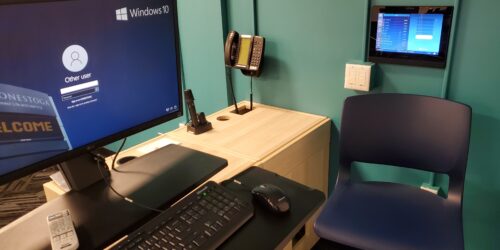
Leveraging Your Slide Deck, Part 2: Engaging Students in the Classroom
A slide deck can be the focus point of a lesson, presenting key information related to the week’s learning outcomes. A slide deck, however, is not simply an overview of content to be presented to students: it is also a treasure trove of opportunities for
- scaffolding learning, as you progressively prepare students for evaluations and more complex learning tasks across the semester, and
- getting students actively involved in their own learning so they are co-constructing knowledge with you in class.
In this Hub post, part 2 of 2, we’ll look at strategies to integrate active learning opportunities in your slide deck. “But wait!” some might say: “Why do I need to integrate active learning when I have so much content to cover in so little class time?” It’s a fair question, and the neuroscience of learning gives us an answer.
In a classroom with diverse teaching and learning methods, students are offered multiple different ways to create and connect ideas. Neuroscience tells us that the more connections the brain makes while learning, the better the retention in our memories over time. When you offer students opportunities to become active participants in the learning process, engagement, retention, and metacognition all increase.
Let’s set the scene: You are preparing for the week’s lecture. You are looking at your slide deck and thinking: “There is a lot of information here! How can I get students involved so I’m not reading them content off my slides for three hours?”
Below, we’ll walk through steps you can take to turn slides into activities that offer diverse ways for students to become engaged in their own learning.
Before we get into what happens next, a few notes:
- You may want to consult this overview of active learning activities because we’ll be drawing on related examples in this post.
- The activities listed below include options for both in-person and online synchronous delivery. Some online options can also be implemented during in-person teaching, such as Padlet or Mentimeter.
- To boost student engagement, activities are intended to be implemented regularly throughout the teaching period, in quick bursts. Larger activities in a second or third teaching hour are excellent ways of asking students to apply learning, but they don’t preclude offering regular opportunities for students to get involved.
- On a related topic to the present post: If you’d like some tips on managing large slide decks, consult this Hub post on “Dealing with Too Many Slides”.
Steps you can take . . .
Step 1
Download and save a copy of the slide deck for the upcoming week. You’ll be modifying the deck, so it’s important to have open a version of the file that you can change and save.
Step 2
Look through the slide decks and consider if the lesson currently has the elements of a BOPPPS lesson plan. As a recap, BOPPPS is a lesson planning framework comprised of a Bridge-in, Pre-Assessment, Participatory Learning, Post-Assessment, and Summary. While there are different methods to planning lessons, BOPPPS is useful for our purposes here because of its emphasis on active learning.
Check if the slide deck has all the elements of BOPPPS. If not, make notes in your slide deck using the highlighter or comment functions so you can include missing elements and craft relevant activities.
The following table provides an example of how a lesson plan can be broken down into activities according to the BOPPPS framework. Notice the diversity and frequency of opportunities for students to actively participate while learning concepts.
Lesson Topic: Families and caregivers as stakeholders in patient care.
Relevant Learning Outcome: Identify the roles families and caregivers play as stakeholders in patient care.
| BOPPPS element | Possible active learning activity |
| Bridge-in | – You begin with a story to the class (e.g., about a family advocating for a sick loved one in hospital). – Ask follow-up discussion questions: What do you think this family was feeling? What would you do in this situation? |
| Pre-Assessment | – Students complete Menti multiple choice quiz (3 questions, anonymous, completed individually to avoid bias) on family and caregiver rights in Canadian healthcare contexts. – All debrief results through discussion: what students already know, where they’re uncertain. |
| Participatory Learning | 1. Students define key terms using course materials and the internet – students work in small groups; regroup as a class and you provide guidance based on their initial research. 2. You present a case study. Using a jigsaw technique, students rotate through small groups and identify as many relevant issues to the family or caregivers in the case study as possible. Students compile issues on the whiteboard or a Padlet as they work. All debrief and group common themes. 3. Students rejoin the group they worked with in activity #1, choose one of the issues debriefed on the whiteboard/Padlet, and develop a short role play scenario featuring a family member/caregiver interacting with a healthcare professional (e.g., a doctor or a nurse). Each group presents their short role play to the class. As students listen to each other, they are to identify the roles they see the family members/caregivers playing in each scenario. |
| Post-Assessment | – Students complete a Menti word cloud or sticky notes on the white board: share the roles identified while listening to peers’ presentations. |
| Summary | – You bring the class back to the relevant learning outcome, emphasizing the diversity of roles we’ve identified today. You set up next week’s topic. |
Step 3
Now that your slide deck contains all the elements of BOPPPS, look for other areas in the deck where activities can be added to get students involved. Use the comment or highlighter functions to flag slides that lend themselves to activities.
| Slides that lend themselves to activities | For example |
| Definitions of terms | Students craft rough definitions using the Internet or other permitted aids; you guide their responses and add material they might miss. |
| Frameworks, processes, timelines | Students draft and order the components in small groups; you fill in details and course correct. |
| Descriptions of roles, duties, or positions | Students brainstorm and draft descriptions first in pairs, then by joining another pair to collect ideas in a team of four; in debriefing with the whole class, you offer additional input. |
| Diagrams, charts, images | Students collectively annotate or label on a shared document; you offer suggestions and provide feedback. |
| Equations | Students solve sample equations in teams and present their results in a shared document; you compare their answers to a key. |
| Discussion questions | Students craft an initial response in a think-pair-share, then summarize their key points on a piece of poster paper or a Padlet; you verbally review their responses and offer feedback. |
| Scenarios | Students analyze a mini-scenario, related to the week’s topic, in small groups and present their findings to the rest of the class in a two-minute verbal summary; you collect a list of common themes on the whiteboard or a shared document. |
Step 4
Now that your slide deck includes activities, it’s time to think about implementation. Consider the following when implementing activities in class.
- How will you provide instructions? Instructions given while setting up activities should be clearly communicated and readily accessible, and in several modalities, for example verbally as well as written on a slide, the whiteboard, or in the chat.
- Be prepared to repeat and clarify instructions during the activity. Welcome questions and receive them with openness and interest. (For self-reflection, note areas where students are confused: such confusion can be a hint that greater clarity or a different approach are needed next time.)
- Circulate to ensure student comprehension and progress during the activity. This will mean walking around the classroom space or joining breakout rooms to observe students as they work. Circulating not only allows you to assist students as required, but also lets you assess their approaches and responses to the activity. What are they struggling with? Where are they engaged?
- To consolidate learning and clarify the significance of an activity, ensure there is adequate time in class to debrief every activity. Options to debrief include:
- Class discussion
- Think-pair-share
- “Muddiest point” – what was the most difficult or confusing thing about the activity?
- Word cloud or collected responses on the whiteboard
- Whatever option you choose, the debrief should give students space to reflect on the learning that has happened and ask follow-up questions.
- Ensure you respond to student contributions offered during an activity. Acknowledge, validate, and build on what students have contributed. This demonstrates to students that you are interested in hearing from them and their perspectives are important to learning, which further encourages participation.
- Within any given lesson, you can scaffold activities so that they become increasingly complex. For example, you might first model how to do something (during the Bridge-in, let’s say) before students complete that same task in small groups (early in the Participatory Learning piece), and then ultimately complete the task on their own (say, in the Post-Assessment).
- Including a variety of activities is an excellent way to invite student interaction and boost engagement, but too many disparate tasks can cause confusion and overshadow their purpose. That’s why lesson planning can help create focus for the day: What are we learning today and why?






